 1927: When Ketchikan was the Largest City in Alaska 80 year old article catches Ketchikan's boom time By DAVE KIFFER April 30, 2007
The epithet was somewhat tongue in cheek, and yet an article in the April, 1927 Alaska Magazine (no relation to the current Alaska magazine) noted that Ketchikan - then Alaska's largest city - was seen by many in The Last Frontier as a "way station" to the "great outside." "When one has resided in the interior and westward parts of Alaska where the present weekly mail service is still regarded as a luxury, and the airplane service still looked upon as a marvelous thing, it is rather exhilarating to stand in one's hotel window in Ketchikan and look down upon the dark forest of masts in the basin, and watch the myriad of lights of craft large and small moving up and down the roadstead," wrote article author John Edward Meals for the magazine that focused on economy and history and was then published monthly in Juneau. 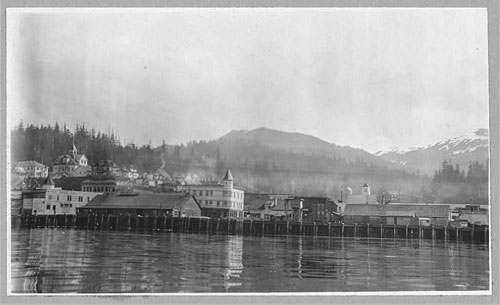 Forms part of: Frank and Frances Carpenter collection (Library of Congress). Gift; Mrs. W. Chapin Huntington; 1951. Photograph courtesy Library of Congress
"To an old sourdough, it is all something like the thrill a spiritualist gets when the table moves," Meals wrote. "Something of the thrill that tunnel men get when the heading is about to break through and they hear voices from the other side of the mountain." To use a more recent vernacular, in 1927, the bustling metropolis of more than 6,000 people that was Ketchikan was Bush Alaska's "interface" with the outside world. Meals was particularly impressed with Ketchikan's internal transportation options. "Ketchikan has no street cars as of yet, and her taxi drivers seem to be careful, considerate gentlemen who charge very reasonably for their services and, despite the general hustle and hurry and rather narrow streets have really few accidents with their fine big cars," Meals wrote. Ketchikan's newspaper (the Chronicle) and the local radio (KGBU?) were also signaled out as examples of "big city" media. "Of course, other Alaskan cities have newspapers and eight page ones too, but somehow the divorces and the shootings and holdups seem to come egregiously hot off the platter down here," Meals wrote. "There is radio here too. No one really understands what a miracle this thing is unless he has tuned in his little receiving set in a lonely camp in the wilderness and evoked eerie, heavily music from a symphony 5,000 miles away, music that comes out of the sky in strange contrast with the soughing of wind through the black spruce." 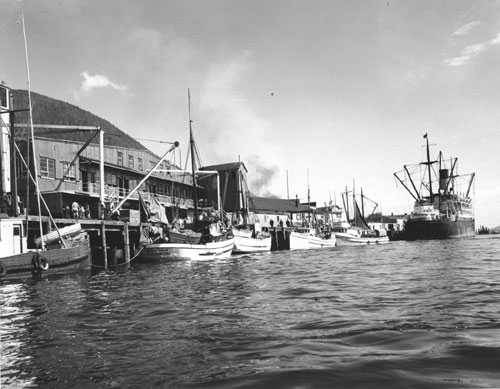 Creator: Haddon, E. P. Source: FWS; Photograph courtesy U.S. Fish and Wildlife Service Like many cities in Alaska, Ketchikan in 1927 was still populated by many of its founders. "He (Meals notes generically, as it was common to not name people in magazine stories in the 1920s unless they were famous individuals) probably came to the territory as a cannery employee or fisherman, this leading man of today, and saved some of his money to open up a little store," Meals wrote. "Then suddenly one day (you realize) that this bird has puttered around a few years.taking a long shot at this and that venture in the commercial game and now is a rich man." Or perhaps, Meals conjectures, the "leading man" was involved in the timber industry. "There were days perhaps when the torrential summer showers had swept by, leaving the wooded islands all great and sweet smelling.when the axe bit smartly into cedar and spruce," Meals wrote. "Well those days are past now for many of Ketchikan's builders and one wonders if at few hundred thousand in the bank is really compensation for the joys off the fight that is now over and won. One thinks not, for these men are still in the battle." The fact that people were still "fighting" the fight to carve Ketchikan from the wilderness despite the "big city comforts" was obviously important to Meals. "Perhaps the most impressive thing about the city is the feeling of bustle and hustle and 'business is good' that permeates the very air," Meals wrote. "The wharves lie within a stone's throw of the hotels and there is never a moment that one steamer and sometimes six or eight may not be seen down below loading fish and unloading passengers." 1927 was the height of the salmon canning boom and Ketchikan's 6,000 residents briefly outstripped the population of Juneau. Neither Anchorage nor Fairbanks had yet to experience the major growth that would eventually make them Alaska's dominant cities. The size of the local salmon industry - more than a dozen canneries were operating along the waterfront - and the halibut industry certainly caught Meals' attention. "Something like a thousand schooners operate out of the port," Meals noted, with some exaggeration. "Unquestionably, the phenomenal growth of Ketchikan is due in a great measure to its fishermen, who unlike the cannery people bring their families with them to live at the home port. They are fine people. Many of them are Scandinavians or rather of Scandinavian descent.." 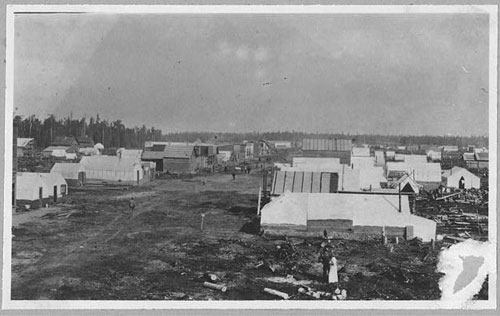 Forms part of: Frank and Frances Carpenter collection (Library of Congress). Gift; Mrs. W. Chapin Huntington; 1951. Photograph courtesy the Library of Congress.
Meals delved into the brief - barely 40 years in 1927 - history of the community, even going as far back the Spanish, English and Russian explorers of the late 1700s. He noted that the Spanish had a different name for what eventually became known as Dixon Entrance, they called it "Entrada de Perez." Meals also took a stab at a question that vexes locals to this day. What does "Ketchikan" really mean and where did the word actually come from? "There are numberless explanations of the meaning of the word Ketchikan; one may take it as 'running water,' 'laughing water' or almost anything that the fancy of the narrator suggests, and the matter is open to much dispute," Meals wrote, noting that local Native leader William Paul said that it was derived from two Tlingit words that could not be directly translated but had some relation to the island's location to the mainland. Meals said that Paul contended that "Ketch" referred to a birds wing and that "kan" referred to shoreline. "Tebenkof (the Russian American Company Director who drew up the first great atlas of Alaska in the late 1840s) says that Wrangell Island used to be called 'Ketch-khanna' and a similar likeness may be seen there," Meals wrote. "At any rate, while there is plenty of running and laughing water in Ketchikan, there is apparently none in the name itself." But, of more interest to Meals, was the economic vitality of the First City. 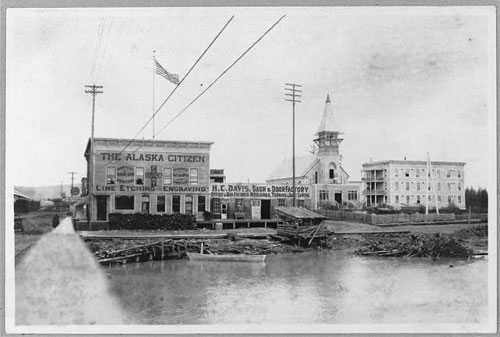 Forms part of: Frank and Frances Carpenter collection (Library of Congress). Gift; Mrs. W. Chapin Huntington; 1951. Photograph courtesy Library of Congress
"One likes the trait of admitting that there is 'much rain,' " Meals added. "There is a great deal of rain but it does not seem to deter the crocus from pushing up in March or be any detriment to the giant Sitka Spruce, nor is the charm of Ketchikan ladies lessened a whit by the slickers and boots and sou-wester hat which are such necessary parts of the well-dress woman's wardrobe." One part of Ketchikan's economy in 1927 gets absolutely no mention in the dozen pages of Meals article: Creek Street. He could hardly have missed it. Those were the years when Alaska's famous jurist and territorialadministrator James Wickersham was calling Ketchikan "Alaska's Tenderloin" and the "Barbary Coast of the North" in newspapers from New York to Seattle. 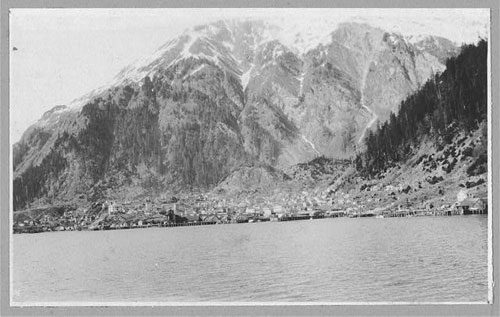 Forms part of: Frank and Frances Carpenter collection (Library of Congress). Gift; Mrs. W. Chapin Huntington; 1951. Photograph courtesy Library of Congress.
There were advertisements at the back of the magazine for the Gilmore Hotel ("the last word in modern, fireproof hotel buildings"), the Ingersoll Hotel ("all the things you expect to find in a 'Big City' hotel'") and Tongass Trading Company ("The largest marine supply house in Alaska") . In 1927, Ketchikan was definitely open for business and - at 6,000 residents - was the largest city in the territory. But by 1930, the canned fishing industry began to wane and the federal government was building up its presence, boosting Juneau back into the top spot. Soon the World War II boom turned Anchorage into the dominant city in Alaska. But for a few brief years -
as captured by the article in Alaska Magazine - Ketchikan was
Alaska's "Big City."
On the Web:
Dave Kiffer is a freelance writer living in Ketchikan, Alaska. A republication fee is required. Contact Dave at dave@sitnews.us
|